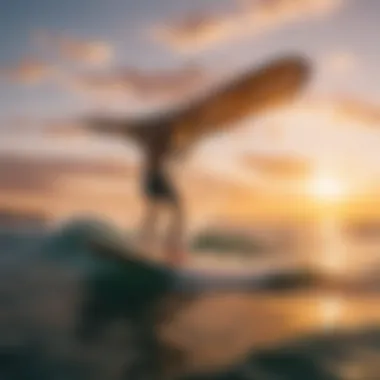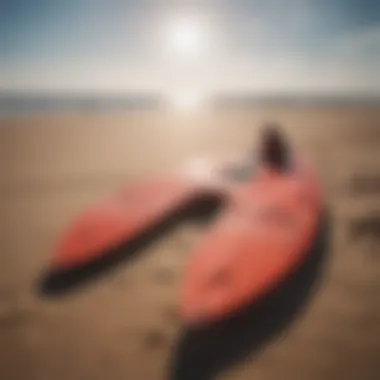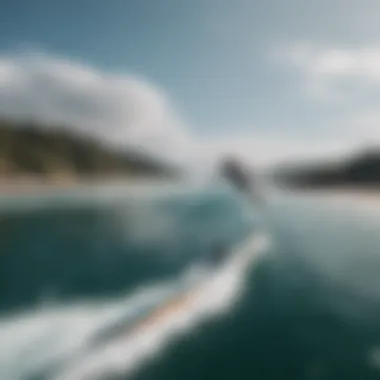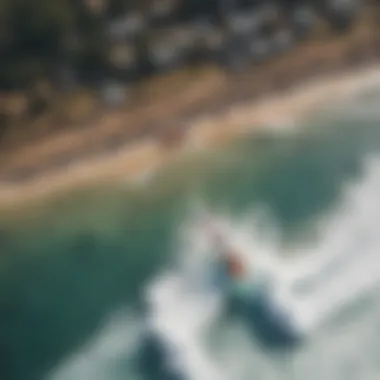Mastering Wing Surfing: Techniques and Insights


Intro
Wing surfing, a thrilling sport that has caught the attention of water sports lovers around the globe, blends the excitement of windsurfing and kiteboarding. It's a relatively new discipline, but its growth in popularity speaks volumes about its appeal. From the first time a rider feels the pull of the wing combined with the glide of the board, it becomes clear this sport is more than just a passing phase. It's a way to connect with wind and water in an entirely unique manner.
As this activity gains traction, many are drawn to its dynamic nature but may feel overwhelmed by the options available. This guide is designed to be a both compass and map for those venturing into the world of wing surfing. It will cover the essential gear, key skills, and best practices to not only enhance your experience but also promote safety and respect for the environment.
By the end of this article, whether you've just dipped your toes into this sport or are ready to carve your name into the sea, you'll find yourself equipped with a wealth of knowledge to navigate the waves with confidence.
Gear Selection
When diving into wing surfing, the first hurdle to clear is choosing the right gear. The vast array of options can make one feel like they’re standing at a crossroads, contemplating which path to take. Let's take a closer look at the key components of your wing surfing set-up.
Types of Kites
Kites are not mere accessories; they are the lifeblood of wing surfing. The various designs and sizes cater to different conditions, skills, and preferences:
- Rigid Wing: These kites offer maximum power and stability, making them perfect for experienced riders looking to tackle stronger winds.
- Inflatable Wing: Ideal for beginners, this type has a forgiving nature. They are easier to control, offering a more stable experience as you learn the ropes.
- Foil Wing: A more advanced option, the foil wing provides an exhilarating ride, especially for those who wish to skim over the water's surface.
When selecting a kite, one must consider the wind conditions of the location where they plan to surf. A small kite might be perfect for high winds, while larger kites shine in lighter breezes.
Choosing the Right Board
The second pillar of your surfing gear is the board. This choice is vital as it will affect your riding style and comfort:
- Freestyle Boards: These are typically shorter and wider, designed for tricks and jumps. If impressive stunts excite you, this might be your go-to board.
- Surfboards: Characterized by their longer and narrower shape, they excel in waves, allowing for smooth riding and cutting through water.
- Foil Boards: An intriguing option for advanced surfers, these allow you to glide above the surface, giving you a sensation of flying.
Choosing the right board often comes down to personal preference and the types of conditions you wish to ride in. It's wise to test different shapes and sizes before settling on your piece of equipment.
Skill Development
Understanding the gear is just the beginning. To truly enjoy wing surfing, developing your skills is essential. The learning process can be as thrilling as the actual surfing, as each small achievement leads you closer to mastery.
Essential Techniques
Getting started means grasping some fundamental techniques that form the foundation of wing surfing. Here are a few crucial pointers:
- Body Positioning: Maintaining a balanced stance is key. Keep your knees slightly bent and your weight distributed evenly over the board.
- Wing Control: Learning to control the wing’s angle in relation to the wind is critical. It’s all about finding the sweet spot between lifting and stability.
- Turning and Carving: Practice smooth transitions and turns. This can be tricky at first, but with persistence, it’s a rewarding skill to develop.
Progression Tips
As you grow in skill level, here are some useful tips to help further your progression:
- Practice Regularly: Consistency makes a world of difference. The more you practice, the quicker you’ll progress.
- Join a Community: Finding fellow wing surfers is invaluable. They can dispense tips, support, and often organize group outings.
- Stay Informed: Keep up with developments in gear and techniques. The sport is always evolving, and so should your knowledge.
"Surging ahead in wing surfing is not just about power; it’s a dance with the wind, requiring finesse and a deep understanding of nature's rhythms."
In sum, wing surfing presents a blend of challenge and joy. With the right gear and a commitment to skill development, you can glide over the water with confidence and style, ensuring every outing is brimming with potential for excitement.
Prolusion to Wing Surfing
Wing surfing, a fascinating blend of wind and water sports, has woven its way into the fabric of outdoor recreation. As a relatively new activity, it offers an exhilarating way for water enthusiasts to experience the thrill of riding over waves with just a wing for propulsion. This section lays the groundwork for understanding what wing surfing is all about, its significance, and the appeal it holds for various groups including kiteboarders, instructors, and enthusiasts.
Exploring the realm of wing surfing means diving into aspects that range from the basic mechanics to the gear needed for a successful session on water. With wind playing such a crucial role, understanding its dynamism can make or break a day out on the sea. At its core, wing surfing combines elements from kiteboarding, windsurfing, and even surfing, resulting in a hybrid sport that attracts a broad audience interested in new challenges and experiences.
For those eager to experiment with this sport, the benefits are manifold. It offers flexibility in terms of skill levels; whether you are a novice just dipping your toes in the water or a seasoned kiteboarder, wing surfing presents a unique playground. Emphasis is placed not just on the thrill, but also on the camaraderie it builds among participants—the community around wing surfing is vibrant and welcoming.
Key Elements to Consider in Wing Surfing
- Dynamic Wind Conditions: Riders need to understand how to utilize varying wind conditions to their advantage.
- Physical Demand: It combines physical strength with a sense of balance, making it not just a pastime but a workout.
- Environmental Awareness: As the activity grows, being mindful of its environmental footprint becomes increasingly essential.
"Understanding the rhythms of the wind and water can elevate your experience from ordinary to extraordinary."
In summary, this introduction aims to elevate the reader's awareness and appreciation for wing surfing, setting the stage for a deeper exploration into its mechanics, techniques, and essential gear. With this knowledge, both novices and veterans alike can gain insights into mastering wing surfing and connecting with the broader kiteboarding community.
The Mechanics of Wing Surfing
Understanding the mechanics of wing surfing holds the key to mastering this thrilling sport. It's about harmonizing your body with the wind, water, and equipment to achieve balance and control. Each element plays a critical role, from the way the wing generates lift to how you navigate the board. Getting a grip on these mechanics not only enhances your experience but also amplifies safety—both for yourself and the environment.


How Wing Surfing Works
At its core, wing surfing is a confluence of wind and water dynamics that creates an exhilarating experience. The wing, which resembles a giant kite, is held in the hands while the rider stands on a board. But what does this actually entail? When the wind fills the wing, it creates lift, allowing the rider to glide over the water. Riders can adjust the angle of the wing to manage speed, direction, and elevation. With practice, the synergy between the rider, the board, and the wing can be artfully choreographed, resembling a dance on the water.
Key Techniques for Success
Controlling the Wing
One of the pivotal aspects of wing surfing is controlling the wing. Mastery over this skill allows riders to catch the wind effectively, leading to smoother rides and more maneuverability. The primary characteristic of wing control lies in how well you can angle the wing relative to the wind direction. A well-controlled wing acts like a compass, guiding you along your chosen path.
A unique feature of wing control is the ability to adjust your stance and hand positioning to accommodate varying wind conditions. For instance, in light winds, a more upright position with a slight wing tilt can harness the breeze more effectively. Conversely, in stronger gusts, lowering the wing and assuming a more crouched posture can offer stability. The balance between control and responsiveness can sometimes be tricky, but honing this skill dramatically enhances your riding experience.
Balancing on the Board
Next up is balancing on the board, which remains central to riding confidently. This involves distributing your weight wisely to counteract the forces acting upon you, from the drag of the water to the lift from the wing. The key characteristic of effective balance is finding that sweet spot where you neither lean too far forward nor backward.
What sets this aspect apart is the interplay between grip and foot positioning. The board’s design also impacts balancing—some boards are wider, offering more stability, while others are sleek, promoting speed. Various riders develop their unique tricks, yet all emphasize the necessity of a steady, controlled center of gravity. While it may come with its challenges, achieving good balance not only makes for entertaining rides but also minimizes the risk of falling.
Turning and Maneuvering
Lastly, turning and maneuvering is essential for navigating waters effectively. This skill involves more than just changing direction; it’s about mastering the art of dynamic movement. The key characteristic to note is the precision with which you can orient the wing and board in tandem. A smoothly executed turn feels effortless; however, it requires a keen understanding of wind and water interaction.
The uniqueness of maneuvering lies in combining foot pressure and wing tilt. For instance, applying pressure on the rear foot while tilting the leading edge of the wing can help in making sharper turns. As you become proficient in this, you’ll find that smoothly transitioning through maneuvers can turn any body of water into your personal playground.
"The mechanics of wing surfing may seem complex, but when broken down, they unlock a world of freedom and adventure on the water."
Essential Gear for Wing Surfing
Wing surfing is not just about technique; it’s also about having the right gear. The equipment you choose plays a vital role in your comfort, safety, and performance. Without the proper gear, even the best skills can fall flat. Choosing suitable wings and boards can significantly enhance your experience on the water, allowing riders to fully embrace the thrill of gliding over waves with ease.
Choosing the Right Wing
Size and Shape Considerations
When it comes to the right wing, size and shape are paramount. The size determines the amount of lift you will have while out on the water. Investing time to understand how wing size affects performance can lead to better choices and a more enjoyable experience. A bigger wing often equates to greater lift, making it a preferred option in lighter wind conditions. On the other hand, a smaller wing gives more maneuverability and speed in consistent winds.
A unique feature of shape is how it affects stability and responsiveness in various conditions. Wings with a wider span can help with stability, whereas those with a more pointed design can cut through the air better. It’s worth noting that a wrong choice here can lead to frustration.
Material Composition
Material also plays a critical role in the efficiency and durability of the wings. Most wings are made from durable materials like ripstop nylon or TPU. Ripstop nylon, for instance, has a good strength-to-weight ratio and is resistant to tears. It helps players avoid equipment fatigue, making it a common choice for many enthusiasts.
Another excellent aspect of wing materials is their impact on performance. High-quality materials ensure that the wing can handle diverse conditions, providing reliability when you’re out in the elements. A disadvantage can be the price, however, as more durable options can be on the pricey side.
Board Selection
Types of Boards
Selecting the right board often dictates your overall experience. Different styles suit distinct riding conditions. Foil boards, for example, are gaining traction among riders who desire speed and a high level of responsiveness. On the flip side, all-around boards are designed for everyone, making them appealing to novices and experts alike.
A high point of these boards is their versatility. They can be used in various conditions, making them a sensible investment. However, specialist boards may offer better performance when used in their ideal conditions.
Fitting to Skill Level
Matching board selection to the rider’s skill level is paramount. Novice riders typically benefit from wider boards that provide more balance, thus boosting confidence on the water. As those skills develop, transitioning to narrower and more performance-oriented boards can offer a completely new experience.
It's crucial to take into account that the wrong board can impede your progress. A beginner on a performance-oriented board may struggle to find their footing, leading to early discouragement.
Safety Equipment
Wetsuits and Harnesses
Safety cannot be overlooked in wing surfing. Proper protection comes from investing in quality wetsuits and harnesses. Wetsuits are primarily designed to provide thermal insulation and buoyancy, which is essential during lengthy sessions. Without the right wetsuit, you'll feel every ounce of chill that comes from the breeze and water.
It’s also good to consider harnesses. They take pressure off your arms and make it easier to control the wing, especially in dynamic conditions. Adjustable harnesses can provide a bespoke fit, which is crucial for comfort.
Impact Vests
Another vital piece of safety equipment is the impact vest. These vests add a layer of protection against falls and collisions, which is particularly important when learning new techniques or riding in crowded areas. They are often designed to float, offering added security in case of accidental falls.


Impact vests also vary in thickness and materials. A thicker vest might offer better impact absorption but can be cumbersome. While that adds extra safety, it might not be ideal for all riders. Picking a vest that balances safety and comfort is essential.
In summary, the right gear for wing surfing is fundamental not just for performance but also for safety. Getting to know your options in wings and boards can significantly enhance your experience, ensuring that every ride is as enjoyable as it should be.
Skill Development in Wing Surfing
When it comes to mastering wing surfing, skill development is the cornerstone of success. Understanding how to advance through various levels—beginner, intermediate, and advanced—can make all the difference. It’s not just about getting out there on the water; it’s about honing your abilities and embracing continuous improvement.
Progressing through these stages requires dedication and a keen learning mindset. Each phase presents unique challenges and learning opportunities. It’s through skill development that one can truly appreciate the nuances of this thrilling sport.
Progressing from Novice to Expert
Initial Training
Initial training sets the groundwork for everything that comes after. This is where newcomers embark on their journey, often under the guidance of experienced instructors. The primary focus here is on mastering the basic controls of the wing and becoming confident on the board.
One key characteristic of initial training is its structured approach. Most programs start on land, helping individuals understand wing handling without the immediate challenge of balance. This step is crucial because it builds muscle memory, which is essential for when you finally hit the water. The structured steps taken during initial training often make it a popular choice among beginners.
However, not everyone has access to formal training. The lack of direct instruction can be a drawback, particularly for those who may struggle without guidance. Yet, with online resources and community forums available (like those found at reddit.com), beginners can still find valuable tips and learning materials.
Intermediate Techniques
Once athletes have grasped the basics, intermediate techniques come into play. This includes refining control over the wing and learning to navigate various wind conditions. Here, riders often focus on increasing their speed and understanding the dynamics of those gusts.
The central aspect of intermediate techniques lies in their adaptability. Riders begin to develop a personal style, allowing them to experiment and push their limits. This period is vital for building confidence and improving overall performance. Many find the thrill of mastering these mid-level skills to be incredibly rewarding. The unique feature of intermediate techniques is the blend of challenge and independence it offers, giving riders room to grow while still feeling supported.
However, there are challenges too. The risk of misjudging conditions can lead to frustrating falls or even injuries. Therefore, some riders might find it beneficial to continue strengthening their foundational skills before attempting to tackle these intermediate challenges.
Advanced Maneuvers
Delving into advanced maneuvers is where the sport truly comes alive. Riders who reach this level have already invested significant time mastering controls and developing personal techniques. Characters of advanced maneuvers often include jumps, spins, and tricks that require not just skill but also a profound understanding of wind patterns and water currents.
The unique feature of this level is the focus on creativity. All riders can showcase their individuality and personal expression through their maneuvers. This complexity makes mastering advanced techniques a sought-after goal among dedicated wing surfers. But be warned: the level of risk increases. Riders can be more prone to falls or injuries if proper technique isn’t maintained. This makes the process slower and demands quite a bit of patience, but the payoff is well worth the effort.
Tips for Continuous Improvement
Solo Practice
Solo practice is an often-overlooked aspect of skill development. It allows riders to refine their personal style without the pressure of an audience or instructor. When practicing alone, surfers have the freedom to experiment with techniques at their own pace.
One of the essential characteristics of solo practice is flexibility. Riders can choose when and where to practice, allowing them to adapt sessions based on their personal schedule and conditions. However, the independent approach comes with its disadvantages as well; without feedback, it can be easy to fall into bad habits. Finding a balance can be key.
Working with Instructors
For those seeking rapid improvement, working with instructors is invaluable. Structured lessons can pinpoint weaknesses and provide tailored advice to accelerate learning. Instructors often share insights into techniques that self-taught riders might not grasp on their own.
The unique feature here is the personalized feedback, which guides and sharpens skills effectively. This practice is beneficial for those at all levels. However, it often comes at a price, which might not suit everyone’s budget.
"Investing in your skills through instruction can save you time and frustration in the long haul."
For those hesitant about ongoing classes, consider attending workshops or clinics that focus on specific techniques. These provide a blend of individual practice and professional guidance, allowing continued learning while fostering community connections.
Safety and Environmental Considerations
Wing surfing, while exhilarating and liberating, necessitates a careful approach to safety and environmental consciousness. The natural backdrop plays a significant role not just in the thrill of the sport but in how it's experienced. Thus, understanding the risks involved and how to mitigate them, as well as respecting the ecosystems where wing surfing takes place, cannot be overstated.
The importance of prioritizing safety protocols lays the groundwork for a secure experience. Beginner surfers, especially, must be equipped with the knowledge to prevent accidents, ensuring both personal well-being and the enjoyment of the sport. On a broader scale, adhering to safety measures contributes to the sustainable growth of wing surfing as a community-driven activity.
Understanding Safety Protocols
Understanding the safety protocols entails familiarizing oneself with local regulations and guidelines. Each surf spot can have its own set of rules, often set in place to protect both riders and the environment. For instance, knowing the right distance to maintain from other watercraft and beachgoers is crucial for minimizing accidents.
Moreover, utilizing appropriate gear, such as impact vests and wetsuits, is fundamental. Riders need to be aware of the equipment standards to ensure maximum protection against injuries. Always checking weather conditions, tides, and wind patterns can make the difference between a thrilling adventure and a perilous experience. A proactive approach to safety helps cultivate a culture of responsibility in the sport.
Respecting Nature
Respecting nature bumps up against another critical aspect of wing surfing — protecting the environment. This sport often takes place in magnificent yet delicate ecosystems, which can be adversely affected by careless actions.
Minimizing Impact


Minimizing impact signifies reducing the physical footprint while engaging in wing surfing. It includes practices like not disturbing wildlife during outings and picking up any litter that may have ended up in the water. The key characteristic of minimizing impact is responsibility. This choice is popular among environmentally conscious surfers who acknowledge their role in the larger ecosystem.
A unique feature of adopting this practice involves choosing locations that are designated for water sports, which minimizes disruption to sensitive areas. However, it's worth noting that every action has its pros and cons; while some spots may offer stunning views, they might also house endangered species or fragile coral reefs that need protection.
Sustainable Practices
Sustainable practices in wing surfing further bolster environmental respect. This approach encompasses utilizing eco-friendly gear made from sustainable materials and promoting recycling among the surfing community. The key characteristic of sustainable practices lies in longevity. Choosing gear that lasts minimizes waste and supports a greener future for the sport.
A hallmark of sustainable practices is the focus on education — raising awareness about responsible surfing and training up-and-coming surfers on eco-conscious habits. Despite this, sustainable practices may not always be financially appealing to everyone, as eco-friendly products sometimes come with a higher price tag. However, investing in sustainability can yield long-term benefits not only for the sport but also for the planet.
"By embracing safety and environmental mindfulness, we not only enhance our own experience but also pave the way for future generations to engage with wing surfing in harmony with nature."
Wing Surfing Destinations
Understanding the varied landscapes of wing surfing is crucial not just for the thrill but also for the potential it holds for both leisure and skill advancement. The right destination can make all the difference, transforming a simple outing into a formative experience. Selecting the perfect spot involves thoughtful consideration of various elements such as wind conditions, geography, and the local culture surrounding the sport. A prime location offers rich opportunity, not only for achieving the ultimate ride but also for connecting with a community that shares your passion.
Popular Locations Worldwide
Coastal Sites
When one thinks about wing surfing, coastal sites naturally come to the fore. They serve as not just a backdrop but as canvases colored by the prevailing winds and waters. The breathtaking coast of Maui, for instance, features steady trade winds complemented by pristine waters. Riders flock here for the consistent breezes, enabling them to practice maneuvers or simply ride the waves.
Key characteristics such as accessibility to launching points and safety awareness also enhance coastal spots like Cabarete in the Dominican Republic. These locations offer other benefits such as local amenities geared towards providing full support to both novices and seasoned riders alike.
On the flip side, while coastal sites are often fruitful ground for wing surfers, they can present challenges. Crowds during peak seasons can choke the waters, making it hard to find space to practice. Also, varying tides may require notice as they can shift quickly, impacting safety and comfort levels for surfers.
Ideal Wind Conditions
Wind is the lifeblood of wing surfing, and thus exploring ideal wind conditions cannot be overstated. Locations celebrated for their perfect breezes, like the Great Lakes in the United States, make headlines for wing surfers who seek thrilling rides in structured settings. Here, the wind often blows consistently throughout the day, helping riders to master control and enhance their skills.
A key draw of such locations is the predictability of conditions, minimizing the guesswork involved in planning a surfing session. Moreover, places like Hood River in Oregon are known for having varying wind patterns throughout the year, catering to different skill levels. On calm days, beginners can find solace while more advanced surfers can step out on breezy days for a challenge.
However, it’s essential to be aware that not every surfer will handle every wind condition with ease. Strong gusts can be intimidating and dangerous, especially for beginners. Hence, it’s advisable to check local weather forecasts while considering one's experience before riding at specific spots.
Local Cultures and Communities
Beyond just waves and winds, local cultures and communities add depth to the overall wing surfing experience. Many hotspots are filled not only with surfers but with people who appreciate the ocean, nature, and the thrill of the sport. This diverse mix creates an enriched experience that goes beyond individual thrill. Communities often host events, workshops, and local competitions that can help newer riders find their footing while allowing seasoned surfers to share their weathered insights.
In places like Tarifa, Spain, the local interaction can be just as exhilarating as the surfing itself. Known for strong winds, Tarifa has a vibrant community where riders and spectators merge, creating a well-rounded ambiance suited for savoring the experience as a whole.
While immersing oneself in these cultures can yield rewards, it's equally important to embrace the local customs and practices with respect. This could mean anything from participating in beach clean-up days to seeking guidance from seasoned locals about the nuances of the water. Fortifying relationships with the communities enhances the overall wing surfing journey, making each ride not just about the sport, but about the connections formed along the way.
"Community means we have each other's backs both on and off the water. The experience of wing surfing can become so much richer when shared."
These destinations serve not just as places to ride; they encapsulate an ethos that resonates with the spirit of wing surfing itself.
The Future of Wing Surfing
Wing surfing, an exhilarating water sport, has shown remarkable growth since its inception. As technology evolves and the community around this sport expands, the future of wing surfing holds immense promise. Embracing a combination of innovation and passion, it's increasingly accessible to people of all ages and skill levels. This section highlights key elements for understanding the trajectory of wing surfing, focusing on technological advances and the sport's widening appeal.
Technological Advances
Technological advancements play a pivotal role in enhancing the wing surfing experience. Every season sees new gear hit the market, pushing the limits of performance and user-friendliness. For instance, the materials used in wings have been refined, resulting in lighter and more durable constructions. Innovations like inflatable wings allow for easier transport and set up while improving stability during rides.
Moreover, advancements in boards, including hydrofoils, have transformed the way artists of wing surfing approach their craft. With beginner-friendly designs and intricate shapes catered to expert surfers, there's something that appeals to every rider.
"The continuous refinement of gear will not only elevate performance but also encourage newcomers to join the sport, as it becomes easier and safer to learn."
Growth of the Sport
As wing surfing gains traction globally, we witness a diverse wave of new enthusiasts joining the ranks. This growth is shaped by specific demographics looking for fresh experiences in outdoor activities.
New Demographics
The rise of new demographics interested in wing surfing cannot be understated. Younger generations, increasingly conscious of health and sustainability, seek outdoor thrills while maintaining a connection to nature. Wing surfing offers an escape from screens and urban life, integrating physical activity with the enjoyment of the winds and waves. The sense of community associated with the sport attracts those looking to make lasting connections.
Unique features within these demographics, such as social media engagement, are proving beneficial. Platforms like Instagram and TikTok see users sharing their experiences, inspiring others to take the plunge into wing surfing. This visibility breeds a cycle of excitement, whereby spectators turn into participants and eventually masters of the art.
Competitive Opportunities
As wing surfing continues to collect enthusiasts, competitive opportunities also expand. Various local, national, and international competitions have sprung up, featuring events tailored to both amateurs and seasoned pros. This competitive environment adds a layer of excitement and motivation for participants. The thrill of competition forces riders to sharpen their skills and innovate their techniques, fostering a culture of constant improvement.
Moreover, these competitions provide a platform for showcasing talent and creativity. New styles and maneuvers are developed to impress audiences and judges alike. However, the competitive side can also bring pressure, which may deter some from fully enjoying the sport at their own pace. Evaluating the balance between competition and personal enjoyment is vital in ensuring the sustainable growth of wing surfing.
In summary, the future of wing surfing appears bright. With consistent technological improvements and the sport's potential to attract diverse participants, it stands on the brink of becoming a fixture in the landscape of water sports. The open waters are calling, and there’s a place for everyone to answer.















